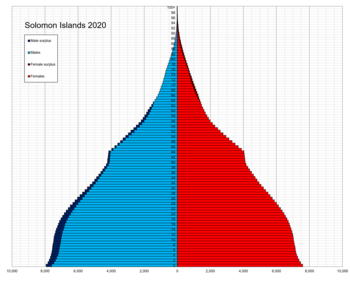| Demographics of Solomon Islands | |
|---|---|
 Population pyramid of the Solomon Islands in 2020 | |
| Population | 702,694 (2022 est.) |
| Growth rate | 1.72% (2022 est.) |
| Birth rate | 22.71 births/1,000 population (2022 est.) |
| Death rate | 3.96 deaths/1,000 population (2022 est.) |
| Net migration rate | -1.55 migrant(s)/1,000 population (2022 est.) |
| Age structure | |
| 0–14 years | 32.99% |
| 65 and over | 4.51% |
| Nationality | |
| Nationality | Solomon Islander |
| Major ethnic | Melanesian (95.3%) |

Demographic features of the population of Solomon Islands include population density, ethnicity, education level, health of the populace, economic status, religious affiliations and other aspects.
The Solomon Islanders comprise diverse cultures, languages, and customs. Of its population [1] 94.5% are Melanesian, 3% Polynesian, and 1.2% Micronesian.[2] In addition, small numbers of Europeans and Chinese are registered. About 120 vernaculars are spoken.
Most people reside in small, widely dispersed settlements along the coasts. Sixty per cent live in localities with fewer than 200 persons, and only 10% reside in urban areas.
The capital city of Honiara is situated on Guadalcanal, the largest island. The other principal towns are Gizo, Auki, and Kirakira.
Most Solomon Islanders are Christian, with the Anglican, Methodist, Roman Catholic, South Seas Evangelical, and Seventh-day Adventist faiths predominating. About 5% of the population maintain traditional beliefs.
The chief characteristics of the traditional Melanesian social structure are:
- The practice of subsistence economy;
- The recognition of bonds of kinship, with important obligations extending beyond the immediate family group;
- Generally egalitarian relationships, emphasising acquired rather than inherited status; and
- A strong attachment of the people to the land.
Most Solomon Islanders maintain this traditional social structure and find their roots in village life.
- ^ "Auswärtiges Amt".
- ^ CIA World Factbook. Country profile: Solomon Islands URL Accessed 2007-05-19